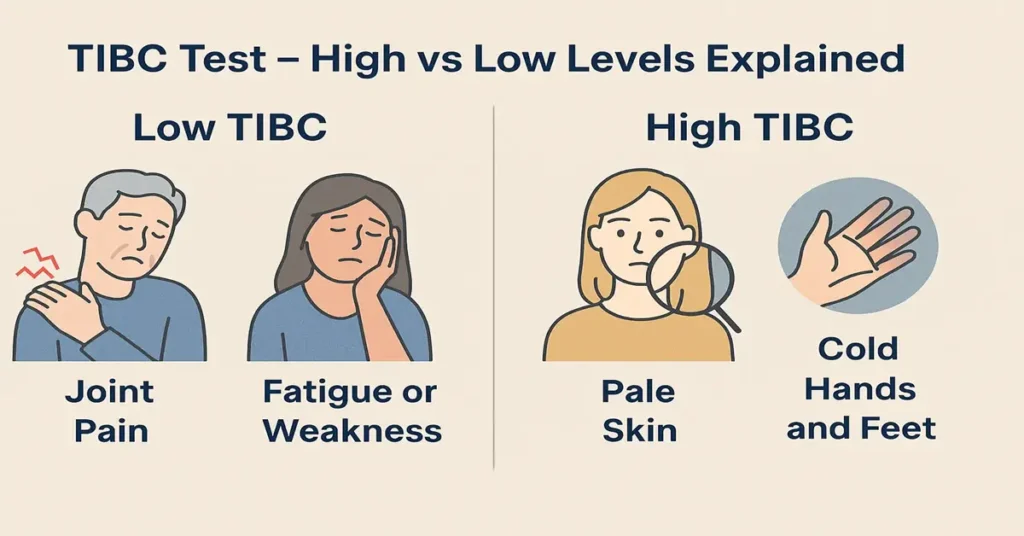Overview
TIBC (Total Iron Binding Capacity) is a blood test that measures how well your blood can transport iron.
It primarily evaluates the amount of transferrin, a protein produced by the liver, that binds to and carries iron through the bloodstream.
The TIBC test is often performed together with serum iron and ferritin tests to give a complete picture of how your body stores, transports, and uses iron.
It helps diagnose conditions like iron deficiency anemia, iron overload (hemochromatosis), or chronic diseases affecting iron balance.
What is TIBC?
TIBC (Total Iron Binding Capacity) measures the maximum amount of iron that can be bound to transferrin in the blood.
In simpler terms, it shows how much iron your body can carry if all the transferrin molecules are fully loaded with iron.
Why it Matters
- When TIBC is high, it usually means your body has less iron but more available transferrin — this is typical in iron deficiency anemia.
- When TIBC is low, it often indicates your body already has too much iron, or that your liver is not making enough transferrin due to disease or inflammation.
Main Functions and Importance of TIBC
TIBC is an indirect measurement of transferrin function and plays a key diagnostic role in iron metabolism.
Its main purposes include:
- Measures Blood’s Capacity to Bind Iron
TIBC shows the total amount of iron that can attach to proteins in the blood, mainly transferrin. - Assesses Transferrin Availability
Helps determine how much transferrin is free to bind iron — an important indicator of your body’s iron transport ability. - Diagnoses Iron-Related Conditions
When interpreted with Serum Iron and Ferritin, TIBC helps identify:- Iron deficiency anemia (low iron, high TIBC)
- Iron overload (hemochromatosis) (high iron, low TIBC)
- Chronic illnesses that affect protein and iron metabolism
- Gives a Complete Iron Status Picture
Doctors use TIBC as part of an iron profile to evaluate how the body absorbs, stores, and utilizes iron.
Causes of Low TIBC
A low TIBC level indicates that the blood’s ability to bind and carry iron is reduced.
This usually occurs when there is too much iron in the body or when protein production is impaired due to illness.
Common Causes:
- Iron overload (e.g., hereditary hemochromatosis)
- Chronic liver disease (reduces transferrin production)
- Malnutrition or low protein intake
- Inflammatory or chronic diseases (like rheumatoid arthritis or chronic infection)
- Nephrotic syndrome (protein loss through urine)
- Hemolytic anemia (iron released from damaged red blood cells increases serum iron)
Symptoms of Low TIBC
(Often due to High Iron or Chronic Illness)
When TIBC is low, it often accompanies symptoms of iron overload or liver-related problems. Common signs include:
- Fatigue or weakness
- Joint pain
- Bronze or greyish skin tone
- Abdominal discomfort or pain
- Liver-related symptoms (swelling, jaundice)
- May have no visible symptoms if due to chronic illness
Severe iron overload can lead to organ damage, especially in the liver, heart, and pancreas.
Causes of High TIBC
A high TIBC value usually means the body has low iron levels and is producing more transferrin to capture and transport additional iron.
Common Causes:
- Iron deficiency anemia – most common cause
- Blood loss – due to injury, menstruation, or ulcers
- Pregnancy – increased iron demand raises transferrin
- Late recovery phase of malnutrition – transferrin levels rise as nutrition improves
Symptoms of High TIBC
(Usually Due to Iron Deficiency)
High TIBC typically reflects low iron and anemia-related symptoms such as:
- Pale or dull skin
- Fatigue and weakness
- Shortness of breath
- Cold hands and feet
- Dizziness or frequent headaches
- Brittle nails or thinning hair
If untreated, prolonged iron deficiency can lead to severe anemia and reduced oxygen supply to tissues.
Reference Ranges
| Parameter | Normal Range | Interpretation |
|---|---|---|
| TIBC | 250 – 450 µg/dL | Normal |
| High TIBC | >450 µg/dL | Iron deficiency |
| Low TIBC | <250 µg/dL | Iron overload or chronic disease |
Note: Normal ranges may slightly vary between laboratories.
Sample Type and Test Details
- Sample Type: Serum
- Tube Used: Red Top (Plain)
- Fasting: 8–12 hours recommended for accurate results
- Associated Tests: Serum Iron, Ferritin, Transferrin Saturation, CBC
How the Test Works
- Blood Sample Collection:
A small blood sample is taken from a vein in your arm. - Measurement:
The lab measures the amount of iron bound to transferrin and calculates the total binding capacity. - Results Interpretation:
TIBC is compared alongside serum iron and ferritin to identify the cause of iron imbalance.
Test Preparation
- Fasting Required: Avoid food and iron supplements for 8–12 hours before testing.
- Morning Test Preferred: Iron levels vary throughout the day.
- Avoid Supplements: Do not take iron or multivitamins before the test unless prescribed.
- Medication Disclosure: Inform your doctor if you’re taking antibiotics, birth control pills, or hormones.
When to Consult a Doctor
You should consult your doctor if you experience:
- Persistent tiredness, weakness, or dizziness
- Pale or bronze skin
- Joint or abdominal pain
- Symptoms of anemia (breathlessness, fatigue)
- Known family history of hemochromatosis or anemia
Abnormal TIBC results may indicate iron imbalance or liver disease, requiring further tests and treatment.
Important Word Explanations
| Word | Meaning |
|---|---|
| Transferrin | A blood protein that binds and carries iron. |
| TIBC | Total Iron Binding Capacity – measures how much iron your blood can carry. |
| Ferritin | Protein that stores iron in the liver and other tissues. |
| Hemochromatosis | A disorder causing the body to absorb too much iron. |
| Nephrotic Syndrome | A kidney condition causing protein loss in urine. |
| Anemia | Low red blood cell or hemoglobin count. |
| Serum | The clear fluid part of the blood after clotting. |
~END~

